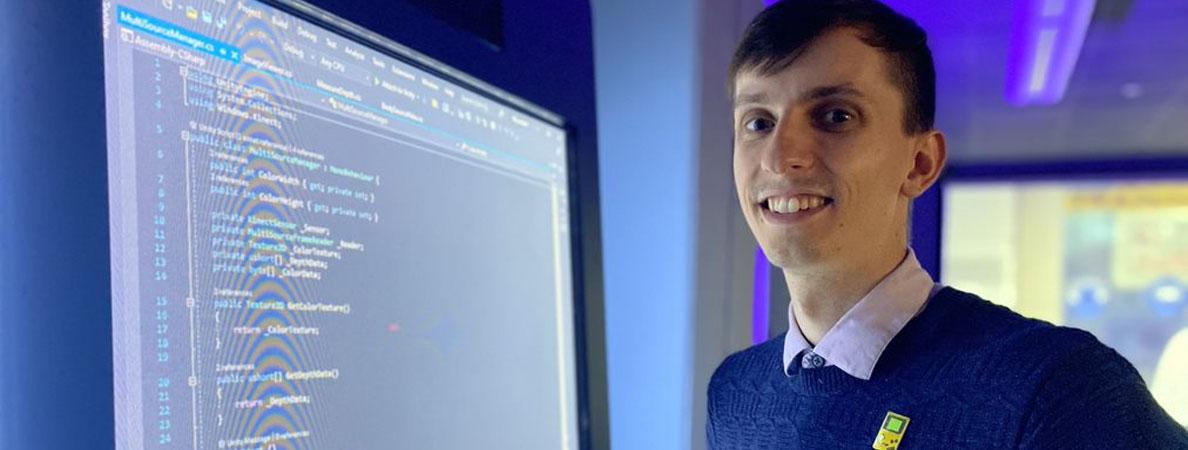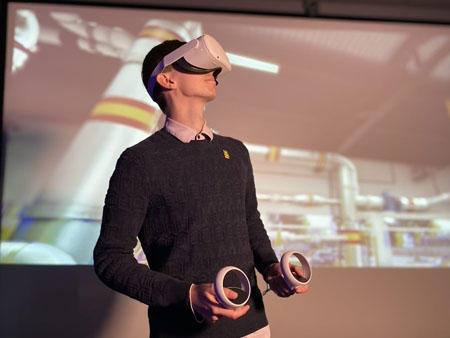
Raphaël Tétreault is one of the driving creative forces behind Mohawk College’s new Game – Design program. The first faculty member to be brought on board for the program, Raphaël will be a professor in the program when it launches, and he is currently helping to create the program.
Raphaël’s journey as a game designer began in 2011 when he chose to attend Sheridan College. “I went to Sheridan with the aspirations of getting into animation,” said Raphaël. “I didn’t get in, so I took some other programs at the time, and I came to learn that while I like animation and I want to work with animators, it wasn’t really the work for me. At the time, they were opening up their game design degree, and I thought it seemed really interesting and so I joined the program.”
Even as a student, Raphaël showed an innate ability for teaching. “Throughout the program, I had a lot of opportunities to mentor and through tutoring and other activities,” he said. “After graduation, one of the faculty thought I was good at mentoring other students on projects, and he told me I should try teaching. Slowly, I taught a couple of courses part-time, and when a position opened up to teach in the program I came from, I took it and taught for 3 years.”
While teaching, he also made games outside of the conventional nature that are designed to educate and help people. “Working on research-based projects, I made games that helped with community outreach,” said Raphaël. “I made a game for York Regional Police, a game that was used in the classroom to help teach epidemiology and forensic anthropology, which is fancy for how viruses spread. I made simulations to teach civilian protection, educational tools, and a bunch of things in between.”
 Through his projects, Raphaël discovered there could be a lot more to games than what we traditionally see and play. “A ton of the projects that I’ve worked on are where I am building a game, but that game has a very specific purpose,” he said. “That’s been an interesting subset of games for me, because you have all the great things from game design in there, but then there’s also an added emphasis on people, on psychology, how you frame things to be engaging. It’s not making a game to make money, it’s about ‘how can we enrich people’s lives.’”
Through his projects, Raphaël discovered there could be a lot more to games than what we traditionally see and play. “A ton of the projects that I’ve worked on are where I am building a game, but that game has a very specific purpose,” he said. “That’s been an interesting subset of games for me, because you have all the great things from game design in there, but then there’s also an added emphasis on people, on psychology, how you frame things to be engaging. It’s not making a game to make money, it’s about ‘how can we enrich people’s lives.’”
When he saw the opportunity to help model the future of the industry by helping to create Mohawk’s Game - Design program, Raphaël knew he wanted to be a part of it. “I saw that the Game – Design program at Mohawk was opening up and hiring, and many of my colleagues encouraged me to apply for it,” he said. “So, I did, and here I am now, helping to build this program. At the moment, I’m doing a lot of curriculum development and building out the program.”
Inclusivity and representation are being taught as an important part of the creative experience and making sure that inclusivity doesn’t come at the cost of creativity. “Equity, diversity and inclusion (EDI) are really important to our program,” said Raphaël. “How can we make sure that students have the skill to coordinate in teams and create an environment where everyone feels welcome to contribute, to be part of the creative process while simultaneously being critical and trying to further develop the project.”
While there are important interpersonal and representational skills being learned in the program, there are hard skills to develop as well. “I’m working on a game engine course, helping students in developing some hard skills in that but also understanding some deeper things that are important there,” said Raphaël. “We have a lot of cool game engines today, but we don’t know if 5 years from now we’ll be using those, so it’s about what’s important about those tools, why do we have them, what challenges we are tackling and how do we use them.”
Raphaël believes the program offers a path that people don’t usually expect to be a part of game development. “I often get asked if the program is more art focused, or if it’s more programming focused,” he said. “The answer is that its neither of those things, there’s actually a third discipline in the middle, design. That’s the core of our program. It’s the part that connects the art with the programming. While we have courses specifically on arts, and we have courses that are more technical, the bulk of the program is about the design component.”
The key to being a game designer is harnessing the power of communication and coordination. “To be a good game designer, the number one skill you need to have is communication,” said Raphaël. “That is your job, you’re a facilitator for communication between teams about ideas, about the needs of different people, providing feedback and listening to feedback.”
He added, “Any kind of work environment that you go into is collaborative. A lot of emphasis throughout the program is the collaborative aspect. You can have all the hard skills in the world, but if you don’t know how to work with other people, you’re never going to get to the end of your project.”
The Game – Design program has been created as a place for anybody and welcomes people of all levels of experience. “Everyone has a different background, and the program is designed in a sense that we assume no prior knowledge for anything,” said Raphaël. “We build everyone up, so they have a very large breadth of skills so that as a designer, you understand how every part of a game is made.
“No matter what kind of design interests you, the program will help you find your place.
We have opportunities for students to try all different sorts of design, and then we help them to hone in on the kind of designer they want to be and develop skills working with that kind of design.”




